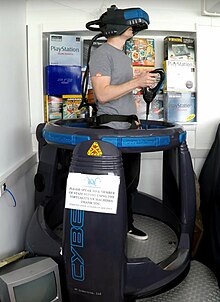
Virtuality was a range of virtual reality machines produced by Virtuality Group, and found in video arcades in the early 1990s.[1] The machines delivered real-time VR gaming via a stereoscopic VR headset, joysticks, tracking devices and networked units for a multi-player experience.
Virtuality Group was originally founded in October 1987 as "W Industries", named after Dr. Jonathan D Waldern, and renamed to Virtuality in 1993.[2][3] Work by Waldern at the Human Computer Interface Research Unit of Leicester Polytechnic (now De Montfort University), which later moved to Loughborough University, had by 1986 produced a system known as the "Roaming Caterpillar" that could deliver a stereoscopic view of a three-dimensional scene.[4] The image was viewed on a moveable CRT screen using shutter glasses, with head and hand tracking incorporating acoustic sensors to determine the user's position.[5][6] Waldern subsequently formed W Industries to commercialise 3D visualisation technology together with colleagues Al Humrich, Richard Holmes and Terry Rowley. The team would produce multiple prototype VR units (including the "giraffe", which was a mechanically tracked headset mounted on a boom arm) with a fifth prototype version being produced by 1989 that would form the basis of the first commercially released Virtuality system.[5]
The Virtuality 1000SU VR system was launched in 1990 at the Computer Graphics ’90 exhibition held at Alexandra Palace in London.[7] There were two types of units, referred to by the company as "pods". In one version the player stood up (SU) and in the other they sat down (SD). Both unit types used a virtual reality headset as a display (described as a "visette" in Virtuality documentation) that contained a pair of LCD screens originally with a resolution of 372x250 per eye. Four speakers and a microphone were also built into the headset.

The first two networked VR systems were sold to British Telecom Research Laboratories to experiment with networked telepresence applications. Many other systems were sold to corporations including Ford, IBM, Mitsubishi and Olin.
The availability of Virtuality systems coincided with a rise in public interest in virtual reality technology in the early 1990s, exemplified by the movie Lawnmower Man. To capitalise on this interest and determining that the largest market for the devices would be gaming, Virtuality produced an arcade variant of the 1000SU for public use called the 1000CS which was released in 1991. The CS postfix referred to "cyberspace" branding which was consistent with language being used in popular media to describe VR environments at the time.
Several non-gaming virtual reality systems were also created by the company including a VR attraction in partnership with Creative Agency Imagination for the launch of the 1995 Ford Galaxy and a virtual trading floor for the London International Financial Futures and Options Exchange (LIFFE).[7]
Sales of arcade gaming systems ultimately declined following the general trend of customers transitioning to primarily home gaming. Virtuality did attempt to produce home VR systems but efforts were not successful and the company entered bankruptcy in 1997. Virtuality assets were sold to Cybermind Interactive Europe. By this time about 1,200 Virtuality arcade machines were in use.[8] The arcade assets were acquired by Arcadian VR in 2004 and then by VirtuosityTech in 2012.[9][10]
- ^ "First US Virtuality center opens in St. Louis". Play Meter. 18 (6): 30. May 1992.
- ^ "W INDUSTRIES CHANGES ITS NAME TO VIRTUALITY, PLANS FLOAT BY CHRISTMAS - Tech Monitor". 1993-09-01. Archived from the original on 2024-03-11. Retrieved 2024-03-11.
- ^ Davies, Hunter (November 22, 1993). "The Hunter Davies Interview: Dr Waldern's Dream Machines". The Independent. Retrieved 10 February 2016.
- ^ Cite error: The named reference
:4was invoked but never defined (see the help page). - ^ a b "Virtuality History". 2022-11-11. Archived from the original on 2022-11-11. Retrieved 2023-11-06.
- ^ Lamb, John (September 1985). "Solid modelling enters a new dimension". Design. p. 11. Retrieved 30 March 2022.
- ^ a b vradmin (2018-04-17). "Virtuality – A New Reality of Promise, Two Decades Too Soon". Virtual Reality Society. Retrieved 2023-08-08.
- ^ Webb, Marcus (February 1998). "Q-Zar and Champions File Bankruptcy; CIE Gets Virtuality Assets" (PDF). Next Generation. No. 38. Imagine Media. p. 35. Archived from the original (PDF) on 2023-04-04.
- ^ "Arcadian Virtual Reality, L.L.C. - ABOUT US". arcadianvr.com. Retrieved 2023-10-10.
- ^ "About Us". VirtuosityTech.com. Retrieved 2023-10-10.